Wireless Charging Market for Electric Vehicles by Propulsion (BEVs, PHEVs), Application (Home & Commercial), Charging Type (Stationary & Dynamic), Component, Power Supply Range, Charging System, Vehicle Type & Region - Global Forecast to 2030
[238 Pages Report] The global wireless charging market for electric vehicles size is projected to grow from USD 80 Million in 2023 to USD 1279 Million by 2030, at a CAGR of 48.4%. Increasing focus toward V2G power transfer and increasing penetration of electric vehicles, paired with strong government support towards wireless EV charging are anticipated to increase the demand for wireless charging for electric vehicles technology all over the world. Additionally rising demand of convenient EV charging and seamless integrated charging solutions consumers deamnds for easy charging experience, elemenating the need of plugging in and unplugging of charging cables and wireless charging offers a solution by enabling effortless, automatic charging.
Advancement in inductive charging technology have created efficient and safely charging solutions for EV. Inductive coupling have increased the power transfer efficiency, allowing for faster charging times that are comparable to traditional plug-in methods. Enhanced safety features, including foreign object detection and communication between the vehicle and charging pad, ensure that the charging process is secure.
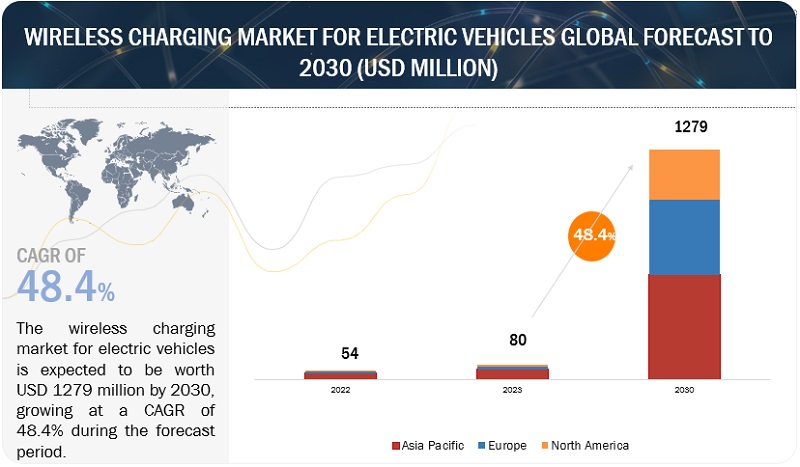
To know about the assumptions considered for the study, Request for Free Sample Report
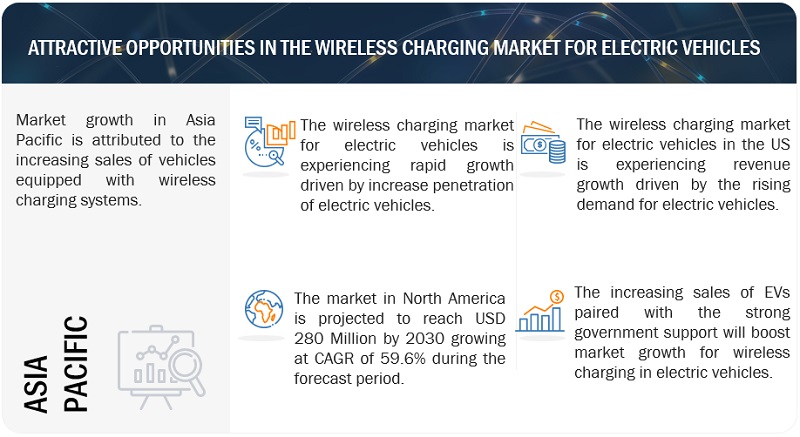
To know about the assumptions considered for the study, download the pdf brochure
Wireless Charging Market For Electric Vehicles:
Driver: Rapid development of fast-charging infrastructure for EVs
During the early stages of the development of electric vehicles, the lack of charging infrastructure remained the key concern for manufacturers and buyers. The rapid development of charging infrastructure in public places, particularly in developed countries, has set aside these concerns of electric vehicle manufacturers as well as potential buyers. For instance, as per the IEA, US has 22,000 units of public fast-charging points in 2021, which got increased and reached 28,000 units in 2022. Whereas in Norway, in 2021 there were 6,700 public fast-charging points which reached 9,100 units in 2022. With more rapid charging stations available, manufacturers and suppliers of wireless charging equipment will be more inclined to promote their products at public and commercial locations. In April 2023, InductEV Inc. announced a strategic cooperation with ChargePoint (US) to increase the availability of high-powered wireless electric car charging systems throughout the United States. This will increase the revenue growth of the wireless charging market for electric vehicles during the forecast period.
All electric vehicles require a charging facility to charge their battery periodically. In addition to home charging stations, manufacturers have provided wireless ev charger at offices, malls, and other public places using innovative technologies to charge vehicles quickly. Due to the low or limited power output home or private chargers take a long time to recharge vehicles. This time get added to the inconvenience of consumers. With advancements in technological, manufacturers have researched better solutions to charge a vehicle in less time than conventional chargers. In cable charging technology, chargers have
different designs or slots. Every charger has a different type of connector, which sometimes makes it difficult for users to find a suitable charger. With the advent of ev wireless charging technology, this problem has been resolved.
Restraint: High cost of upgrading to wireless charging technology
The wireless EV charging system requires transmitter and receiver coils for power transfer with a power control unit (PCU). The transmitter coil is installed in the base charging pad (BCP), and the receiver coil is installed underneath the vehicle charging pad (VCP), The overall wireless charging system for home installation costs around USD 3,000-3,500. The use of wireless charging technology in an electric vehicle increases its cost. As a result, the cost of wireless electric vehicle charging increases. The high cost of wireless electric vehicle (EV) charging infrastructure is expected to be a key obstacle to the broad adoption of wireless charging technology. It could potentially hamper market growth to a certain extent.
The increasing demand for wireless charging and the mass production of electric vehicles will help lower the cost of wireless charging technology. Wireless charging technology is new to the electric vehicle market and is still in the introduction phase. However, this technology is expected to be incorporated by most of the automotive OEMS in their respective car models in the future. Hence, considering the economic environment and induced economies of scale, it can be inferred that the high cost of upgrading to wireless charging technology is a restraint.
Opportunity: Increasing support from governments in wireless charging
Government support and incentives for electric vehicles in many countries now extend to the development of wireless charging. The key advantages of wireless charging are full autonomy, no need for a charging station, reduced chance of the driver getting an electric shock during wired charging, and smaller battery units. Full autonomy helps increase the productive hours of the general public as they need not wait till the vehicle is charged. This increase in productive hours further helps in increasing the GDP of a nation. The other key aspect that favors the installation of wireless charging in urban areas, where space is a premium, is the reduced or no need for a charging station for dynamic charging.
In February 2022, in coordination with the Michigan Department of Transportation (MDOT), the Michigan Office of Future Mobility and Electrification (OFME), and the Michigan Economic Development Corporation (MEDC), Electreon (Israel) announced the deployment of a 1.61 km (1 mile) wireless electric road system in downtown Detroit as part of Michigan Central Station, a new mobility innovation hub being developed by Ford. This project will serve as the first public electric road system for wireless charging of EVs in North America. This project started in 2023 and includes static (stationary) wireless charge points.
In December 2022, Electreon announced plans to deploy the first wireless Electric Road System (ERS) in Germany (on a public road). The ELINA project will feature 1 km of Electreon's wireless dynamic charging and two additional static charging stations in the town of Balingen and will charge an electric bus.
Challenge: Minimizing loss of efficiency
Wireless charging technology has witnessed high growth in the electric vehicle industry. With this technique, the electric car only needs to be parked above the base panel to begin charging; no human connections are needed. However, wireless charging does have certain limits. Power loss is around 7-12% more in wireless charging technology than in traditional power transmission.. In addition, the transmission range of a wireless charger through electromagnetic induction and/or magnetic resonance is limited to a certain distance. This limitation of range poses a serious challenge for manufacturers, especially in the case of LCVs and SUVs with high ground clearance. The efficiency of power is inversely proportional to the distance between the transmitter and the receiver. As strong electromagnetic fields may harm the biological environment, the issue of safety during vehicle charging is a concern in the wireless charging market for electric vehicles. Safety and efficiency issues have thus become a hurdle for wireless charging system manufacturers in this market.
Wireless Charging For Evs Market Ecosystem
The ecosystem analysis highlights various players in the wireless charging for EVs ecosystem, which is primarily represented by OEMs, tier 1 integrators/suppliers, and others. Prominent companies in wireless ev charging market include WiTricity Corporation (US), ElectReon (Israel), InductEV Inc. (US), Plugless Power Inc. (US), Wave Charging (US), and ENRX (Norway), among others.
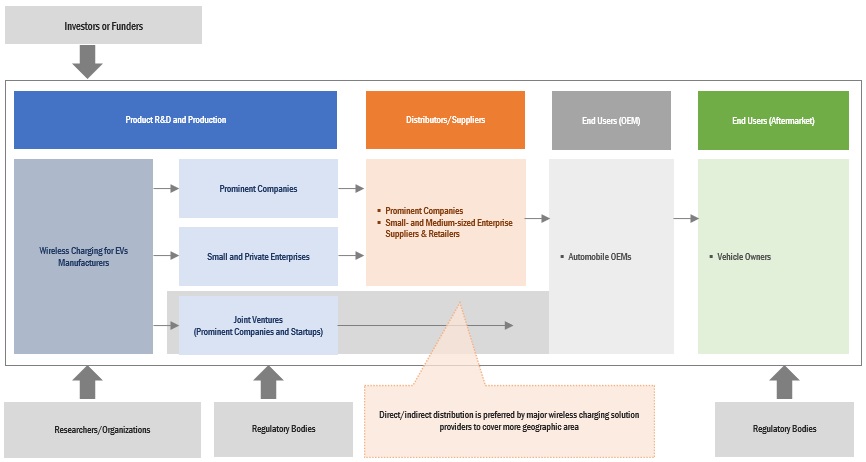
Passenger car segment is expected to witness significant growth rate in the global wireless charging for EVs market during the forecast period
The passenger car segment is expected to have significant growth opportunities in the wireless charging market for electric vehicles during the forecast period. This is owing to the increasing efforts by automotive OEMs to incorporate wireless charging systems in their vehicles such as Hyundai Motor Company (South Korea) offers wireless charging as an option on the GV60 and FAW’s HongQi electric vehicles, and Volvo Car Corporation (Sweden) offers wireless charging as an option on the Volvo XC40 Recharge electric SUV. Increasing customer awareness, technological advancements, and government incentives as in 2019, the EU set a target of having 30 million electric vehicles on the road by 2030, to achieve this target, the EU is offering several incentives, such as tax breaks and grants. All these aforementioned factors are anticipated to bolster the revenue growth of the passenger car segment during the forecast period.
Compared to ICE automobiles, the waiting time for electric vehicles is short in countries like China. Sales of electric vehicles are anticipated to increase in the near future in Europe as a result of the increasingly strict pollution standards. As per the white house.gov, by 2030, the federal government of the United States wants to sell 50% of new electric passenger automobiles and light trucks. Automotive OEMs such as Tesla Inc. (US), Volkswagen (Germany), Honda Motor Co., Ltd. (Japan), Hyundai Motor Company (South Korea), and Ford Motor Company (US) are also investing in the electric vehicle segment owing to the increasing demand for EVs. Increasing the inclination of automotive OEMs towards electrification will certainly increase the demand for wireless charging systems. As such, the use of wireless charging technology is being actively explored by automotive OEMs including Hyundai, BMW Group, and Mercedes Benz Group. Rising awareness about the benefits of electric passenger cars and increasing investments in autonomous driving technology are expected to bolster revenues for the passenger car segment during the forecast period.
BEV segment is expected to be the largest in wireless charging market for EVs during the forecast period
BEVs in the wireless charging market for electric vehicles is expected to be the largest market in Asia Pacific during the forecast period. Several automotive OEMs such as FAW (China), Hyundai Motor Company (South Korea) offer wireless EV charging technology as a standard option in their few vehicle models. Additionally, due to the rising popularity of electric vehicles and more stringent emission standards, battery electric vehicles have a significant growth potential in the market for wireless charging for electric vehicles. Wireless charging manufacturers are also focusing on growth strategies such as new product development, geographical expansion, etc. in the Asia Pacific region. All these aforementioned parameters are expected to bolster the revenue growth for BEV segment of the market for EVs.
Europe is expected to have the noticeable market for BEVs in the wireless charging market for electric vehicles during the forecast period. The market growth in Europe can be attributed to the presence of leading automotive companies that use wireless charging technology. The use of wireless charging by leading players would encourage other key players in the automotive industry to adopt wireless charging technology for BEVs. For instance, according to International Energy Agency (IEA), the BEV car sales in 2021 were 1.2 million units which have grown to 1.6 million units in the year 2022. Thus, an increase in sales of BEVs will lead to increasing investments in EV charging ecosystem. Owing to this, wireless charging providers have stared collaborating with automotive OEMs and charging point providers to offer efficient wireless EV charging solution for EV owners. For instance, in February 2023, HEVO Inc. (US), a leading provider of wireless electric vehicle (EV) charging technology, and Stellantis N.V. (Netherlands), a worldwide automaker and mobility provider, partnered to integrate wireless charging into Stellantis’ electric vehicles. This will enable a superior charging experience for Stellantis’ electric vehicles users. All these aforementioned parameters are expected to increase the demand for the market in the battery-electric vehicle segment.
Magnetic resonance charging segment is expected to have significant growth opportunities in wireless charging market for EVs during the forecast period
The magnetic resonance charging segment is expected to hold the largest share of the wireless charging market for electric vehicles in 2023. This is owing to the increasing acceptance of magnetic resonance charging technology by automotive OEMS such as Hyundai Motor Company (South Korea) and FAW (China) for their several vehicle models. However, inductive charging technology is expected to have significant opportunities during the forecast period. As such, leading wireless charging providers such as InductEV Inc., HEVO Inc., and WAVE Charging, among others, use inductive charging technology for wireless electric vehicle charging. More companies are expected to adopt the inductive power transfer charging system in electric vehicles in the near future.
“The Asia pacific wireless charging market for electric vehicles is projected to hold the largest share by 2030.”
Asia Pacific is estimated to be the largest market for EVs wireless charging by 2030. In this region, countries such as China, Japan, and South Korea are expected to take the lead in autonomous driving technology in the coming years. Leading automobile manufacturers in this region, such as Toyota Motor Corporation, Nissan Motor Co. Ltd., Mitsubishi Motors, and Honda Motor Co., Ltd., have partnered with wireless charging provider to increase the market in region. China is expected to be the most influential factor in the Asia Pacific wireless charging for EVs market in terms of value & volume. The presence of leading market players, such as Shenzhen Vmax New Energy Co., LTD. and WiTricity Corporation, and the high customer base are expected to bolster the revenue growth of the wireless charging market for electric vehicles in China during the forecast period.
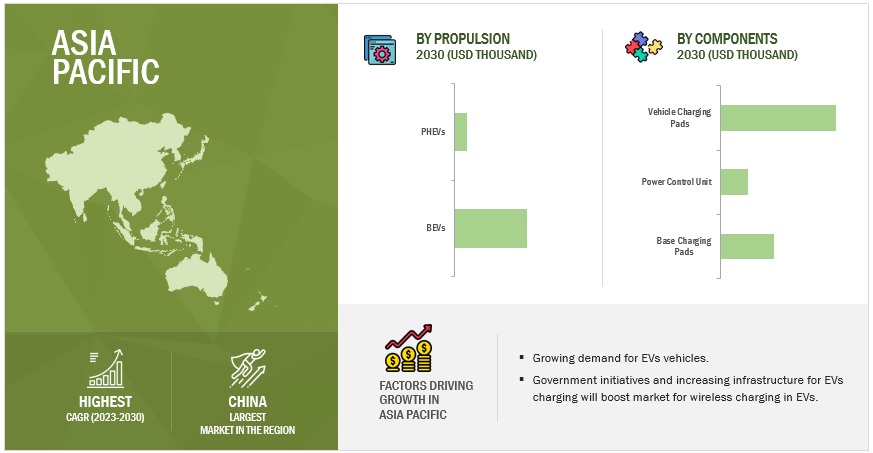
Key Market Players
The global wireless charging market for EVs is dominated by major players such as WiTricity Corporation, ElectReon, InductEV Inc., Plugless Power Inc., Wave Charging, and ENRX, among others.

Want to explore hidden markets that can drive new revenue in Wireless Charging Market?
 Scope of the Report
Scope of the Report

Want to explore hidden markets that can drive new revenue in Wireless Charging Market?

|
Report Metric |
Details |
|
Market size available for years |
2022–2030 |
|
Base year considered |
2022 |
|
Forecast period |
2023-2028 |
|
Forecast units |
Volume (Units) & Value (USD Thousand) |
|
Segments covered |
Power Supply Range, Application, Component, Charging System, Charging Type, Propulsion, Vehicle Type, and Region |
|
Geographies covered |
Asia Pacific, North America, Europe, and Rest of the World |
|
Companies Covered |
WiTricity Corporation (US), InductEV Inc. (US), Plugless Power Inc. (US), Electreon (Israel), and HEVO Inc. (US). |
This research report categorizes the wireless charging market for electric vehicles based on application, component, charging system, charging type, power supply range, propulsion, vehicle type, and region
Wireless Charging Market for Electric Vehicles, By Application:
- Commercial Charging Stations
- Home Charging Units
Wireless Charging Market for Electric Vehicles, By Component:
- Base Charging Pads
- Power Control Units
- Vehicle Charging Pads
Wireless Charging Market for Electric Vehicles, By Charging Type:
- Dynamic Wireless Charging Systems
- Stationary Wireless Charging Systems
Wireless Charging Market for Electric Vehicles, By Propulsion:
- BEVs
- PHEVs
Wireless Charging Market for Electric Vehicles, By Vehicle Type:
- Commercial Vehicles
- Passenger Cars
Wireless Charging Market for Electric Vehicles, By Power Supply Range:
- Up to 3.7 kW
- Above 3.7–7.7 kW
- Above 7.7–11 kW
- Above 11 kW
Wireless Charging Market for Electric Vehicles, By Charging System:
- Magnetic Resonance Charging
- Inductive Charging
- Capacitive Charging
Wireless Charging Market for Electric Vehicles, By Region
- North America
- Europe
- Asia Pacific
- RoW
Recent Developments
- In July 2023, WiTricity Corporation announced the FastTrack Integration Program for vehicle manufacturers. This streamlined program enables automotive OEMs to begin evaluation as well as testing of electric vehicles with wireless charging in just 90 days. The wireless charging will be fully enabled and operational on the automaker’s EV platform using the company’s Halo receiver & Halo 11kW charger.
- In June 2023, Leading manufacturer of commercial vehicles of Nederland, GINAF Trucks collaborated with Electreon to integrate Electreon’s wireless charging system on a GINAF 50-ton truck model. Further to this Electreon and GINAF are also looking at aftermarket installations on additional GINAF trucks, and Mercedes-Benz chassis.
- In April 2023, WiTricity Corporation along with ABT e-Line (Germany), announced to bring wireless EV charging to the streets of Europe. With demonstrated experience working with the Volkswagen Group (VW), ABT e- Line (Germany) will initially upgrade the VW ID.4 model to support wireless charging technology offered by WiTricity Corporation. This model (with wireless charging technology) is expected to be available in the market by early 2024.
- In February 2023, HEVO Inc. collaborated with Stellantis NV (a leading global automaker and mobility provider) to integrate/incorporate wireless charging technology into Stellantis electric vehicles. This, in turn, will enable a superior charging experience with safety, efficiency, and durability.
- In May 2022, the WAVE Charging received a second order of WAVE 250kW wireless charging systems for new Gillig battery-electric buses by Twin Transit which are scheduled to arrive in late 2023.
Frequently Asked Questions (FAQ):
What is the current size of the global wireless charging market for electric vehicles?
The global wireless charging market for electric vehicles is estimated to be USD 80 million in 2023 and projected to reach USD 1279 million by 2030.
Who are the winners in the global wireless charging market for electric vehicles?
The wireless charging market for electric vehicles is dominated by global players such as WiTricity Corporation, Electreon, InductEV Inc., Plugless Power Inc., Wave Charging, and HEVO Inc among others. These companies develop new products, adopt expansion strategies, and undertake collaborations, partnerships, and mergers & acquisitions to gain traction in the wireless charging market for electric vehicles.
What are the new market trends impacting the growth of the wireless charging market for electric vehicles?
The new market trend such as countries shifting to Vehicle-to-Grid (V2G) power transfer and rising acceptance of magnetic resonance charging technology.
Which region is expected to be the largest market during the forecast period?
Asia Pacific is anticipated to be the largest market in the wireless charging market for electric vehicles due to the increasing adoption of wireless charging technology by automotive OEMs, and increasing inclination towards electrification.
What is the total CAGR expected to be recorded for the wireless charging market for electric vehicles during 2023-2030?
The CAGR is expected to record a CAGR of 48.4% from 2023-2030.
To speak to our analyst for a discussion on the above findings, click Speak to Analyst

The study involved four major activities to estimate the current size of the wireless charging market for electric vehicles. Exhaustive secondary research was done to collect information on the market, the peer market, and model mapping. The next step was to validate these findings, assumptions, and sizing with the industry experts across value chains through primary research. The bottom-up and top-down approaches were employed to estimate the total market size. After that, market breakdown and data triangulation were used for determining the market size of segments and subsegments.
Secondary Research
Secondary sources referred to for this research study included automotive industry organizations involved with wireless charging technology; publications from government sources [such as country level automotive associations and organizations, Organisation for Economic Co-operation and Development (OECD), World Bank, CDC, and Eurostat]; corporate filings (annual reports, investor presentations, and financial statements); and trade, business, and automotive associations. Secondary data was collected and analyzed to arrive at the overall market size, which was further validated through primary research.
Primary Research
Extensive primary research was conducted after acquiring an understanding of the Wireless Charging Market for Electric Vehicles through secondary research. Several primary interviews were conducted with market experts from both the demand (OEMs) and supply (wireless charging for electric vehicle manufacturers, service providers, and component manufacturers) sides across major regions, namely, North America, Europe, and Asia Pacific. Approximately 17% and 83% of primary interviews were conducted from the supply side & industry associations and dealers/distributors, respectively. Primary data was collected through questionnaires, emails, and telephonic interviews. In the canvassing of primaries, various departments within organizations, such as sales, operations, and administration, were considered to provide a holistic viewpoint in this report.
After interacting with industry experts, brief sessions with highly experienced independent consultants were conducted to reinforce the findings from primaries. This, along with the in-house subject matter experts’ opinions, led to the findings as described in the remainder of this report.
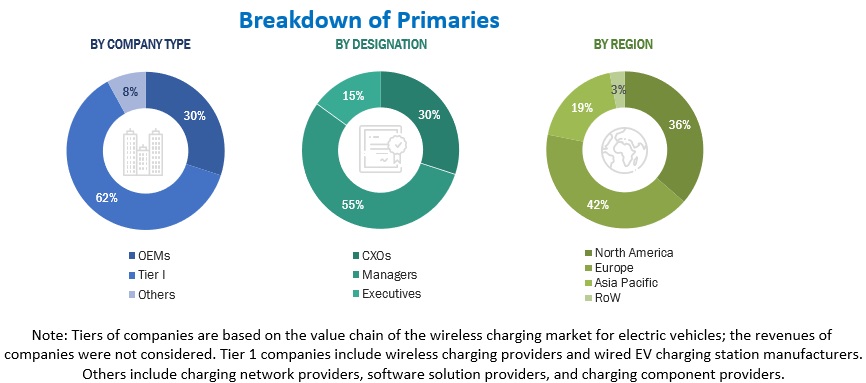
To know about the assumptions considered for the study, download the pdf brochure
Market Size Estimation
The bottom-up and top-down approaches were used to estimate and validate the size of the wireless charging market for electric vehicles. Model mapping was carried out to understand the penetration of wireless charging systems. New vehicle models launched with wireless charging technology were also mapped. In terms of volume, the market size for electric vehicles, by propulsion and vehicle type, was derived by estimating the country-level sales of electric vehicles equipped with wireless charging systems in units. This gives the number of vehicles equipped with a wireless charging system. The summation of all country-level markets gives the regional-level market in terms of volume. Further, average selling prices were identified for wireless charging systems (inclusive of vehicle charging pads, base charging pads, and power control units). Then, the volume numbers were multiplied by the ASP of the wireless technology, which gives the global market for electric vehicles by value.
- The key players in the industry and markets have been identified through extensive secondary research.
- The industry’s future supply chain and market size, in terms of value, have been determined through primary and secondary research processes.
- All percentage shares, splits, and breakdowns have been determined using secondary sources and verified through primary sources.
Global Wireless Charging Market for Electric Vehicles Size: Bottom-Up Approach

To know about the assumptions considered for the study, Request for Free Sample Report
Data Triangulation
After arriving at the overall market size of the global market through the above-mentioned methodology, this market was split into several segments and subsegments. The data triangulation and market breakdown procedure were employed, wherever applicable, to complete the overall market engineering process and arrive at the exact market value data for the key segments and subsegments. The extrapolated market data was triangulated by studying various macro indicators and regional trends from both the demand- and supply-side participants.
Market Definition
Wireless Charging for EVs: As per Zevpoint E-mobility Pvt Ltd, Wireless EV charging uses electromagnetic fields to transfer energy between two coils?(one in the charging station and the other in the EV). This?eliminates the need for a physical connection. This technology enables EV owners to simply park their vehicles over a charging pad, reducing the time and effort required to plug in and charge.
Key Stakeholders
- Association of European Automotive and Industrial Battery Manufacturers (EUROBAT)
- Alternative Fuels Data Center (AFDC)
- Departments of Transportation
- Electric Vehicle Association of Asia Pacific (EVAAP)
- Environmental Protection Agency (EPA)
- European Alternative Fuels Observatory (EAFO)
- European Automobile Manufacturers’ Association (ACEA)
- EV Charging Pole Manufacturers
- EV Charging Station Service Providers
- International Council on Clean Transportation (ICCT)
- International Organization of Motor Vehicle Manufacturers (OICA)
- International Energy Agency (IEA)
- Investor Presentations and Annual Reports of Key Market Players
- Regional EV Charging Associations
- Regional Electric Vehicle Regulatory Authorities
- Society of Manufacturers of Electric Vehicles (SMEV)
- World Electric Vehicle Association (WEVA)
Report Objectives
- To segment the market and forecast its size by charging type, component, application, charging system, propulsion, power supply range, vehicle type, and region
- To segment the market based on application and estimate the home charging unit subsegment by volume and commercial charging station subsegment by qualitative insights
- To segment the market based on charging type and estimate the stationary wireless charging systems subsegment by volume and dynamic wireless charging systems subsegment by qualitative insights
- To segment the market and forecast its size based on vehicle type—passenger car and commercial vehicle
- To segment the market and forecast its size by value, based on component—base charging pads (BCPs), power control units (PCUs), and vehicle charging pads (VCPs)
- To segment the market and forecast its size by volume and value, based on power supply range— up to 3.7 kW, above 3.7-7.7 kW, above 7.7-11 kW, and above 11 kW
- To segment the market and forecast its size by volume, based on propulsion type—battery electric vehicles (BEVs) and plug-in hybrid electric vehicles (PHEVs)
- To segment the market and forecast its size by volume, based on charging system—inductive charging, magnetic resonance charging, and capacitive charging
- To forecast the market size with respect to key regions, namely, North America, Europe, Asia Pacific, and the Rest of the World (RoW)
Available Customizations
With the given market data, MarketsandMarkets offers customizations in accordance to the company’s specific needs.
- Wireless Charging Market for Electric Vehicles, by Charging System, at a Regional Level
- Wireless Charging Market for Electric Vehicles, By Vehicle Type, at Country Level (For countries covered in the report)
- Profiling of additional market players (Up to 5)



 Generating Response ...
Generating Response ...








Growth opportunities and latent adjacency in Wireless Charging Market
Which geography is expected to grow at the highest rate among others in the global Wireless Charging Market for Electric Vehicles from 2022 to 2030?